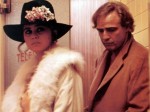In 1972, the New Yorker published a review of Bernardo Bertolucci’s “Last Tango in Paris” in which famed movie critic Pauline Kael argued that the film “had changed the face of an art form.”
More than four decades later, Bertolucci’s masterpiece stands as one of the great films of its era. “Last Tango in Paris” plays this Friday and Saturday at the New Beverly Cinema during its ongoing Marlon Brando retrospective.
“Last Tango in Paris” opens with Paul (Brando) screaming mad at the cacophonic sounds of overhead trains. From the exposition, we know he’s battling some inner demons, and soon it is established that he is tormented by the suicide of his recently deceased wife. He’s an American expatriate, a businessman that haunts the various bars and coffee shops of Henry Miller’s Paris.
Paul soon meets the pretty, young French woman Jeanne (Maria Schneider) and the two begin a purely sexual relationship that plays out like a little game. The rules are clear: one, they meet at a quaint flat and have hushed and heated trysts, and two, neither one knows the other’s name. In fact, they could hardly care about the other’s identity, past or present. It’s trivial, and the anonymity is preferential.
Many films have discussed sex frankly, but rarely has a movie been deemed so detrimental to society that its own director had his civil rights stripped from him – Bertolucci’s suffrage was taken by the Italian courts after the release of the film.
In retrospect, however – after the critics, censors and Catholic religious leaders ceased fighting back, the smoke has cleared and all that remains is a film made in a bygone time – “Last Tango in Paris” still stands as a quintessential film of the 1970s.
The aging Brando, hair graying and face weathered atop his tan overcoat, and the sultry Schneider, wrapped in furs with a wide-brimmed black hat slanted over her eyes, bring a seemingly urbane coolness to the film. Yet they also provide a certain darkness. Their relationship is complicated – initially based solely upon instant gratification, it escalates into a kind of mutual debasement.
Both, but particularly Brando, degrade themselves, strip themselves of their clothes and values, and stand, both figuratively and metaphorically, naked. Both performances are startling, some of the best of their respective careers.
The cinematography by Bertolucci regular Vittorio Storaro is a perfect example of color use in all of cinema. In much the same way that wintry blues and whites were used in Bertolucci’s other masterpiece “The Conformist,” the autumnal shades present in “Last Tango in Paris” give the film a certain atmosphere. The lush oranges, the flesh pinks, the subdued browns and the stark grays present an indescribable beauty in which every frame looks gorgeous and melancholic. The colors pop out and make the images warm, rich and sensuous.
“Last Tango in Paris” is perhaps Bertolucci’s greatest triumph, and it embodies so many of the narrative preoccupations that have persisted throughout his career: sexual liberation, left-wing politics and the interplay of power between individuals. Even now, it still has the ability to shock and provoke its audiences.
What classics films would you like to see receive their time in the limelight again? Email Colvin at icolvin@media.ucla.edu.

For the span of about fifteen minutes – from the start of the opening credit sequence until Paul and Jeanne make love against the window and then leave the apartment they will spend a great deal of the movie in together – this film is cinematic glory at its greatest. The possibilities for the motion picture as a full blown art form are exploited to spectacular advantage in almost every way possible before the flick, unfortunately, starts a gradual slide into cliché, sensationalism, and melodramatic slop, as well as a real slowdown in the sheer virtuosity of the filmmaking. But what a start!!
http://cinemathequequinones.blogspot.in/
For the span of about fifteen minutes – from the start of the opening credit sequence until Paul and Jeanne make love against the window and then leave the apartment they will spend a great deal of the movie in together – this film is cinematic glory at its greatest. The possibilities for the motion picture as a full blown art form are exploited to spectacular advantage in almost every way possible before the flick, unfortunately, starts a gradual slide into cliché, sensationalism, and melodramatic slop, as well as a real slowdown in the sheer virtuosity of the filmmaking.
http://cinemathequequinones.blogspot.in/